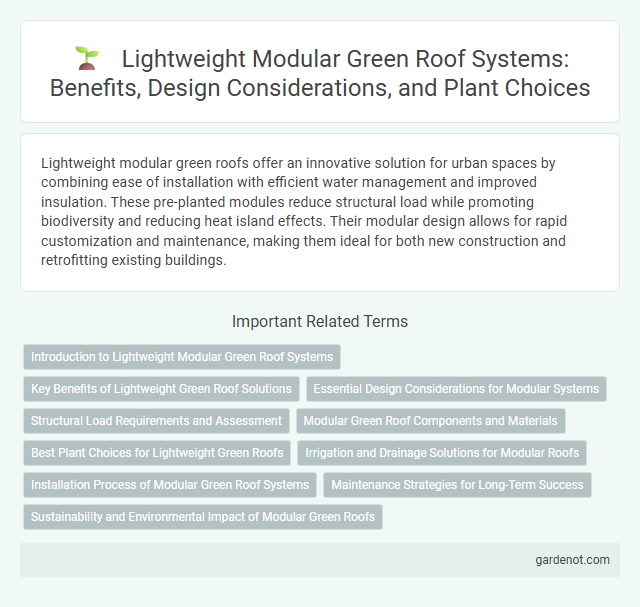Lightweight modular green roofs offer an innovative solution for urban spaces by combining ease of installation with efficient water management and improved insulation. These pre-planted modules reduce structural load while promoting biodiversity and reducing heat island effects. Their modular design allows for rapid customization and maintenance, making them ideal for both new construction and retrofitting existing buildings.
Introduction to Lightweight Modular Green Roof Systems
Lightweight modular green roof systems consist of pre-vegetated trays or panels designed for easy installation on rooftops with limited structural load capacity. These systems reduce overall roof weight by utilizing lightweight growing media, promoting efficient plant growth while minimizing stress on building structures. Lightweight modular green roofs improve urban biodiversity, enhance thermal insulation, and manage stormwater runoff effectively.
Key Benefits of Lightweight Green Roof Solutions
Lightweight modular green roof systems reduce structural load by using specially designed, low-weight growing mediums and modular trays, enabling installation on buildings with limited load capacity. These solutions enhance stormwater management by improving runoff retention rates while promoting biodiversity and thermal insulation, leading to energy savings. Easy installation and maintenance with pre-grown modules significantly lower labor costs and minimize construction time compared to traditional green roofs.
Essential Design Considerations for Modular Systems
Lightweight modular green roofs require careful attention to structural load capacity, ensuring the building can support the added weight without compromising integrity. Drainage systems must be efficiently integrated to prevent water retention and root damage, promoting healthy plant growth. Selecting appropriate substrate depth and lightweight materials optimizes plant diversity while maintaining system manageability and ease of installation.
Structural Load Requirements and Assessment
Lightweight modular green roofs reduce structural load due to their engineered substrate and vegetation layers averaging 15-30 kg/m2, making them suitable for retrofitting on existing buildings without extensive reinforcement. Structural load assessment must account for dead loads, including the weight of the modules when saturated with water, and live loads such as maintenance personnel and environmental factors like snow accumulation. Precise evaluation using load-bearing capacity and deflection limits ensures the integrity and safety of the building structure under the additional green roof load.
Modular Green Roof Components and Materials
Lightweight modular green roofs consist of pre-planted trays made from durable, weather-resistant materials like recycled plastic and lightweight foam substrates that reduce structural load. These modular components include drainage layers, filter fabrics, and growing media engineered for optimal water retention and root support. Utilizing modular green roof systems accelerates installation, enhances maintenance efficiency, and improves overall sustainability performance in urban environments.
Best Plant Choices for Lightweight Green Roofs
Succulents such as Sedum, Sempervivum, and Delosperma are ideal for lightweight modular green roofs due to their low water needs and shallow root systems. Native grasses and drought-tolerant herbs like thyme and lavender also perform well, providing biodiversity without adding excessive weight. These plants enhance roof insulation, reduce stormwater runoff, and require minimal maintenance, making them optimal choices for weight-sensitive rooftop environments.
Irrigation and Drainage Solutions for Modular Roofs
Lightweight modular green roofs incorporate advanced irrigation systems designed to optimize water distribution while minimizing excess runoff. Efficient drainage solutions, such as integrated permeable layers and drainage mats, prevent waterlogging and ensure healthy plant growth by facilitating consistent moisture control. These technologies improve overall roof longevity and reduce the risk of structural damage due to water accumulation.
Installation Process of Modular Green Roof Systems
The installation process of lightweight modular green roof systems involves placing pre-grown vegetation mats or trays onto a prepared waterproof membrane, ensuring quick and efficient setup. Modular systems reduce structural load and streamline green roof deployment by integrating growth media, plants, and drainage layers within compact units. Proper alignment and interlocking of modules guarantee stability and optimal plant coverage, accelerating the establishment of green roofs atop urban buildings.
Maintenance Strategies for Long-Term Success
Lightweight modular green roofs optimize structural load capacity while providing efficient water drainage and root protection through layered components. Regular inspection and cleaning of drainage channels, along with timely replacement of modular trays, prevent system clogging and maintain healthy vegetation growth. Implementing a consistent maintenance schedule that includes irrigation management, fertilization, and pest control is critical for extending the lifespan and sustainability of lightweight modular green roofs.
Sustainability and Environmental Impact of Modular Green Roofs
Lightweight modular green roofs significantly reduce structural load while enhancing urban sustainability by promoting biodiversity and improving air quality. These systems utilize recycled and eco-friendly materials, minimizing environmental impact during production and installation. The modular design facilitates easy maintenance and scalability, contributing to energy efficiency and stormwater management in urban environments.
Lightweight modular green roof Infographic

 gardenot.com
gardenot.com